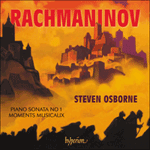
Welcome to Hyperion Records, a British classical label devoted to presenting high-quality recordings of music of all styles and from all periods from the twelfth century to the twenty-first.
Hyperion offers both CDs, and downloads in a number of formats. The site is also available in several languages.
Please use the dropdown buttons to set your preferred options, or use the checkbox to accept the defaults.

| Steven Osborne (piano)» More |
A Lisztian ambition can also be detected in Rachmaninov’s efforts to unify the sonata, which is bound together tightly by a small number of recurring and mutating motifs. The fifths of the introduction, for example, evoke the beginning of Beethoven’s ninth symphony, but they are recast to fit the lyrical character of the second movement, and later punctuate the finale’s turbulent opening theme.
The first movement, true to the character of Faust, is full of anguish and ‘cursed questions’. In the midst of this, a chant-like theme emerges and eventually prevails over the agitation, giving intimations of faith and hope. The titanic struggle that plays out in the rest of the movement culminates in a grand climax that still leaves the drama unresolved, despite the faint glimmer of a major key in the closing moments.
The lyrical slow movement is especially memorable for its beautiful interweaving of voices to produce a texture that is suffused with melody. The pastoral mood gives way to a sense of yearning and striving that rises to great intensity but then dissolves into a cadenza that leads to a reprise of the opening material. The texture is further complicated by trills, which lend the music a new, ecstatic character, and in the coda the two voices singing in duet reveal that the movement was a love scene.
The finale begins tempestuously and leads to a sinister march in which a figure with a dotted rhythm descends step by step. The melodic contours soon remind the listener of the famous opening phrase of the Dies irae chant, which had become the pre-eminent symbol of death in the music of the Romantics. Rachmaninov’s personal obsession with death and the hereafter prompted him to take up the Dies irae phrase again and again. The theme reaches the peak of its full, terrifying glory later in the finale. There are moments of heroism and triumph, distinguished by concerto-like textures, and memories of the preceding movements flood in. The struggle between good and evil continues to the end.
from notes by Marina Frolova-Walker © 2022
On peut également déceler une ambition lisztienne dans les efforts de Rachmaninov pour unifier sa sonate, où un petit nombre de motifs récurrents qui se transforment créent une unité. Les quintes de l’introduction, par exemple, évoquent le début de la neuvième symphonie de Beethoven, mais elles sont reformulées pour correspondre au caractère lyrique du deuxième mouvement, et ponctuent ensuite le premier thème agité du finale.
Le premier mouvement, conforme au personnage de Faust, regorge d’angoisse et de «questions maudites». Au milieu de tout ça émerge un thème dans le style d’une mélopée, qui finit par l’emporter sur l’agitation, donnant des indices de foi et d’espoir. Le combat titanesque qui se déroule dans le reste du mouvement culmine dans un grand sommet qui laisse néanmoins le drame non résolu, malgré la faible lueur d’une tonalité majeure à la fin.
Le mouvement lent lyrique est particulièrement mémorable pour son magnifique entrelacement de voix appelé à produire une texture imprégnée de mélodie. L’atmosphère pastorale fait place à un sentiment de désir ardent et de lutte qui devient très intense avant de s’évanouir dans une cadence menant à une reprise du matériel initial. La texture est encore plus compliquée par la présence de trilles, qui prêtent à la musique un nouveau caractère extatique et, dans la coda, les deux voix chantant en duo révèlent que ce mouvement était une scène d’amour.
Le finale commence tempétueusement et mène à une sinistre marche où une figure au rythme pointé descend pas à pas. Les contours mélodiques rappellent bientôt à l’auditeur la célèbre phrase initiale de la mélopée du Dies irae, qui était devenu le symbole prééminent de la mort dans la musique des romantiques. L’obsession personnelle de Rachmaninov pour la mort et l’au-delà l’incita à reprendre sans cesse la phrase du Dies irae. Le thème atteint l’apogée de toute sa gloire terrifiante plus tard dans le finale. Il y a des moments d’héroïsme et de triomphe, caractérisés par des textures semblables à celles d’un concerto, et des souvenirs des mouvements précédents affluent. La lutte entre le bien et le mal se poursuit jusqu’à la fin.
extrait des notes rédigées par Marina Frolova-Walker © 2022
Français: Marie-Stella Pâris
Ein Liszt’scher Ehrgeiz ist auch in Rachmaninows Bemühungen zu erkennen, die Sonate zu vereinheitlichen, was sich in einer Handvoll von wiederkehrenden und mutierenden Motiven manifestiert. So verweisen die Quinten der Einleitung beispielsweise auf den Beginn von Beethovens neunter Sinfonie, doch sind sie hier umgestaltet und dem lyrischen Charakter des zweiten Satzes angepasst; später unterstreichen sie das turbulente erste Thema des Finales.
Entsprechend dem Faust’schen Charakter ist der erste Satz voller Angst und „verfluchter Fragen“. Mittendrin tritt ein choralartiges Thema hervor, das schließlich die Aufregung überwindet und Glauben und Hoffnung andeutet. Der gewaltige Kampf, der sich im weiteren Verlauf des Satzes vollzieht, erreicht einen eindrucksvollen Höhepunkt, der es allerdings trotz des schwachen Dur-Schimmers in den abschließenden Passagen nicht vermag, die Dramatik aufzulösen.
Der lyrische langsame Satz ist in erster Linie aufgrund der wunderschönen Verflechtung der Stimmen bemerkenswert, wodurch sich eine Struktur ergibt, die von der Melodie erfüllt ist. Die pastorale Stimmung weicht einer Sehnsucht und einem Streben, das immer intensiver wird, sich dann aber in einer Kadenz auflöst, die zu einer Reprise des Anfangsmaterials führt. Die musikalische Struktur wird durch Triller noch komplexer, die der Musik einen neuen, ekstatischen Charakter verleihen, und in der Coda verraten die beiden miteinander duettierenden Stimmen, dass der Satz eine Liebesszene war.
Das Finale beginnt stürmisch und leitet in einen sinister anmutenden Marsch hinein, in dem eine Figur mit punktiertem Rhythmus sich schrittweise abwärts bewegt. Die melodischen Konturen erinnern bald an die berühmte Anfangsphrase des Dies irae-Gesangs, welcher in der romantischen Musik zum Todessymbol schlechthin geworden war. Rachmaninow selbst war vom Tod und Jenseits geradezu besessen, weshalb er die Dies irae-Phrase immer wieder aufgriff. Später im Finale erreicht das Thema den Höhepunkt in seiner vollen, erschreckenden Pracht. Es gibt Augenblicke des Heldentums und des Triumphs, die sich durch konzertante Texturen auszeichnen, zudem erklingen Verweise auf die vorangegangenen Sätze. Der Kampf zwischen Gut und Böse setzt sich bis zum Ende fort.
aus dem Begleittext von Marina Frolova-Walker © 2022
Deutsch: Viola Scheffel
 Rachmaninov: Piano Sonata No 1 & Moments musicaux Rachmaninov: Piano Sonata No 1 & Moments musicaux‘Rachmaninov fans won’t want to miss this’ was Gramophone’s verdict on Steven Osborne’s Études-tableaux, and this thrilling release is an equally essential acquisition. Osborne proves a predictably fine exponent of the Faustian Piano Sonata No 1, ...» More |
 Rachmaninov: The Complete Solo Piano Music Rachmaninov: The Complete Solo Piano Music‘A fine achievement from Howard Shelley and Hyperion alike. These superbly recorded, idiomatic readings demonstrate Shelley's virtuoso pianism and aff ... ‘A significant testimony to Howard Shelley's artistry. Pianistically impeccable, he understands what Rachmaninov was about’ (Gramophone)» More |

